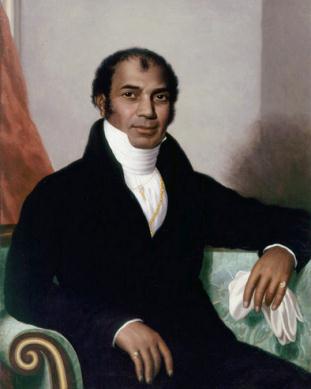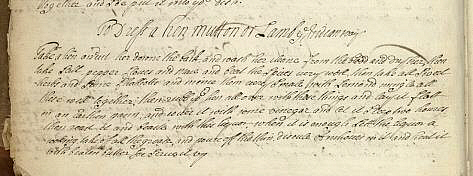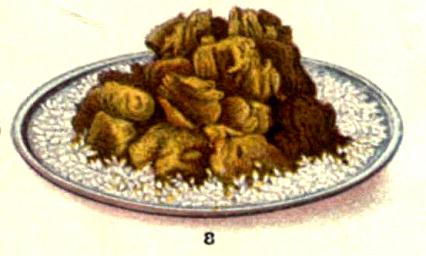

|
 In English practice, re-cooked chopped meat fried with minced onion, curry powder, often with fruit pieces (apples, apricots), moistened to form a sauce. Most traditionally served in England in a mound with a ring of boiled rice around.  Sake Dean Mahomed - Proprietor of the first Curry Shop in England by Thomas Mann Baynes c1810 This general form of curry appears in published English cookbooks from Hannah Glasse's 1747 'The Art of Cookery', through Mrs.B to the present day. As employees, both British and Indian, of the new East India Company began arriving back in England in the 17th century, the nation soon acquired a taste for spicy curry dishes. The extraordinary Bengali businessman Sake Dean (or Din) Mahomet, with his Irish wife, opened what is usually considered to be the first English curry-shop at George Street in London 1810 - about half-a-century before the first fish-and-chip shop. His advertisement for the 'Hindostanee Coffee-House' informed 'the Nobility and Gentry' that he offered "Indian dishes, in the highest perfection, and allowed by the greatest epicures to be unequalled to any curries ever made in England", rather suggesting that, by then, curry was already well-known. And he did take-aways "Such Ladies and Gentlemen as may be desirous of having India Dinners dressed and sent to their own houses, will be punctually attended to by giving previous notice". Morning Post - Friday 02 February 1810 Indeed, a handwritten receipt to "To Dress a Hen, Mutton or Lamb țe Indian Way" has been found (thanks to Laura Kelley at silkroadgourmet.com) dating from about 1675...  Original Receipt from Wellcome Manuscript No MS.4050/7, c1675 Original Receipt from Wellcome Manuscript No MS.4050/7, c1675 To Dress a Hen, Mutton or Lamb țe Indian Way Take a hen and cut her down the back and wash her from the blood and dry her, then take salt, pepper, cloves and mace and beat the spices very well, then take also sweet herbs and some shallots and mince them very small with lemon and mingle all these well together; then rub up the hen all over with these things and lay it flat in an earthen pan and cover it with some vinegar and let it steep two hours; then roast it and baste with this liquorwhen it is enough, set the liquor a cooking, take off the grease, and pour off the hen; dissolve anchovies in it and heat it with beaten butter. So serve it up.  The English form of curry Image: Mrs.B  Original Receipt in 'The Art of Cookery, Made Plain and Easy' by Hannah Glasse, 1747 (Glasse 1747); Original Receipt in 'The Art of Cookery, Made Plain and Easy' by Hannah Glasse, 1747 (Glasse 1747);To make a Currey the Indian way. TAKE two small chickens, skin them and cut them as for a fricasey, wash them clean, and stew them in about a quart of water, for about five minutes, then strain off the liquor and put the chickens in a clean dish; take three large onions, chop them small, and fry them in about two ounces of butter, then put in the chickens and fry them together till they are brown take a quarter of an ounce of turmerick, a large spoonful of ginger and beaten pepper together, and a little salt to your palate. Strew all the ingredients over the chickens whilst it is frying, then pour in the liquor, and let it stew about half an hour. Then put in a quarter of a pint of cream, and the juice of two lemons, and serve it up. The ginger, pepper, and turmerick must be beat very fine.  Original Receipt from 'Modern Cookery for Private Families' by Eliza Acton (Acton 1845); Original Receipt from 'Modern Cookery for Private Families' by Eliza Acton (Acton 1845);A COMMON INDIAN CURRIE. For each pound of meat, whether veal, mutton, or beef, take a heaped tablespoonful of good currie powder, a small teaspoonful of salt, and one of flour; mix these well together, and after having cut down the meat into thick small cutlets, or dice, rub half of the mixed powder equally over it. Next, fry gently from one to four or five large onions sliced, with or without the addition of a small clove of garlic or half a dozen eschalots, according to the taste; and when they are of a fine golden brown, lift them out with a slice and lay them upon a sieve to drain; throw a little more butter into the pan and fry the meat lightly in it; drain it well from the fat in taking it out, and lay it into a clean stewpan or saucepan; strew the onion over it, and pour in as much boiling water as will almost cover it. Mix the remainder of the currie-powder smoothly with a little broth or cold water, and after the currie has stewed for a few minutes pour it in, shaking the pan well round that it may be smoothly blended with the gravy. Simmer the whole very softly until the meat is perfectly tender: this will be in from an hour and a quarter to two hours and a half, according to the quantity and the nature of the meat. Mutton will be the soonest done; the brisket end (gristles) of a breast of veal will require twice as much stewing, and sometimes more. A fowl will be ready to serve in an hour. An acid apple or two, or any of the vegetables which we have enumerated at the commencement of this chapter, may be added to the currie, proper time being allowed for cooking each variety. Very young green peas are liked by some people in it; and cucumbers pared, seeded, and cut moderately small,, are always a good addition. A richer currie will of course be produced if gravy or broth be substituted for the water: either should be boiling when poured to the meat. Lemon-juice should be stirred in before it is served, when there is no other acid in the currie. A dish of boiled rice must be sent to table with it. A couple of pounds of meat free from bone, is sufficient quite for a moderate-sized dish of this kind, but three of the breast of veal are sometimes used for it, when it is to be served to a large family-party of currie-eaters; from half to a whole pound of rice should then accompany it. The small grained, or Patna, is the kind which ought to be used for the purpose. Six ounces is sufficient for a not large currie; and a pound, when boiled dry, and heated lightly in a dish, appears an enormous quantity for a modern table. To each pound of meat, whether veal, mutton, or beef, 1 heaped tablespoonful of good currie-powder, 1 small teaspoonful of salt, and a large one of flour, to be well mixed, and half rubbed on to the meat before it is fried, the rest added afterwards; onions fried, from 1 to 4 or 5 (with or without the addition of a clove of garlic, or half a dozen eschalots); sufficient boiling water to nearly cover the meat: vegetables, as in receipt, at choice; stewed, 11/2 to 21/2 hours: a fowl. 1 hour, or rather less; beef, 2 Ibs., 11/2 hour, or more; brisket of veal, 21/2 to 3 hours. Obs. - Rabbits make a very good currie when quite young. Cayenne pepper can always be added to heighten the pungency of a currie, when the proportion in the powder is not considered sufficient. Search Foods of England for more about: Curry...  |
|
MORE FROM Foods of England... Cookbooks ● Diary ● Index ● Magic Menu ● Random ● Really English? ● Timeline ● Donate ● English Service ● Food Map of England ● Lost Foods ● Accompaniments ● Biscuits ● Breads ● Cakes and Scones ● Cheeses ● Classic Meals ● Curry Dishes ● Dairy ● Drinks ● Egg Dishes ● Fish ● Fruit ● Fruits & Vegetables ● Game & Offal ● Meat & Meat Dishes ● Pastries and Pies ● Pot Meals ● Poultry ● Preserves & Jams ● Puddings & Sweets ● Sauces and Spicery ● Sausages ● Scones ● Soups ● Sweets and Toffee ● About ... ● Bookshop ● Email: editor@foodsofengland.co.uk COPYRIGHT and ALL RIGHTS RESERVED: © Glyn Hughes 2022 BUILT WITH WHIMBERRY |